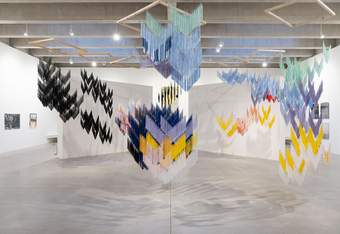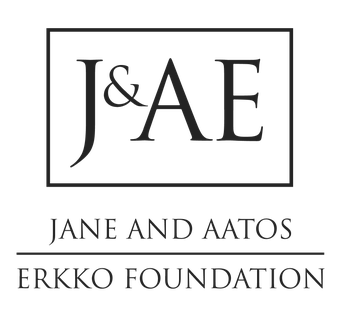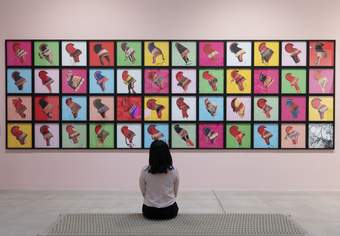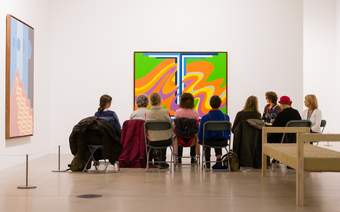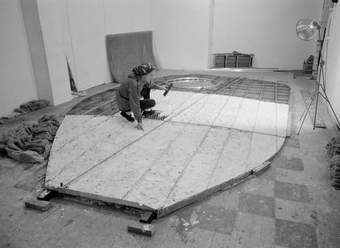Outi Pieski is a Sámi visual artist based in Ohcejohka (Utsjoki), Finland. This will be her first large-scale exhibition in the UK.
Pieski's paintings and installations explore several themes, including the culture and identity of the Sámi people – who live in the region of Sápmi, which now includes the northern part of Scandinavia and Kola peninsula in Russia.
In many of her projects, she incorporates duodji (the traditional craft practices of the Sámi people) using materials such as wood and textile. For Pieski, duodji is also a way of revitalising connections between past and future generations.
Through this thought-provoking show, Pieski raises important questions around ancestral return, indigenous people’s rights, and the relationship between humans, animals and nature.
Outi Pieski is based in Ohcejohka (Utsjoki), Finland, in the cultural region of Sápmi. Sápmi is the traditional territory of the Sámi people that extends across parts of northern Norway, Sweden, Finland and Russia. Pieski's paintings, prints and installations raise questions which have far-reaching relevance, considering Indigenous peoples' rights, ancestral return, and the relationship between humans, animals, and land.
Pieski's practice embodies the Sámi philosophy of soabadit (positive reciprocity). Soabadit balances life with the environment by uniting spiritual, ancestral, elemental and practical knowledge. This holistic Sámi worldview is essential for living in the harsh Arctic region but has historically been endangered by missionary programmes and assimilation policies that oppressed ancient Sámi customs, languages and rights. Pieski explores the possibilities of art in strengthening contemporary Sámi culture and expertise, which are critical in understanding and protecting the Arctic environment.
Pieski paves the way for reconnecting ancestral knowledge with the troubled present and future times. She often uses Sámi duodji (handicraft) techniques and works collaboratively, revitalising traditions and opening intergenerational dialogues. This exhibition of Pieski's work is accompanied by texts written by curators, academics and advocates, reflecting on their shared experiences, concerns and the biocultural reality of Sámi communities today.
This is Pieski's debut large-scale exhibition in the UK. It begins with several early works, tracing the artist's development across materials, processes, and influences and her increasing involvement as a spokesperson and activist for Sámi people's rights and environmental stewardship.
DUODJI
Duodji is a Sámi word meaning art, handicraft or home-craft. Pieski created the ‘three-dimensional painting’ Beavvit / Rising Together II with women duojárs (duodji practitioners) using traditional Sámi shawl-crafting techniques. Pieski describes the laborious activity of weaving the knots as a ‘matriarchal counterforce to a competitive, individual–centred society’. The work title is Northern Sámi for ‘many good friends’ and is close to the word beaivi (the sun). Outi Pieski: ‘Duodji is doing and making, crafting and creating. It is a holistic concept that preserves the Sámi philosophy, values and spirituality and connects them with practical skills. In Sámi culture, material is seen not as passive but as an active author. Material items hold energy and power. The energy comes from the material itself, the maker who has transformed the material through skills, care and love, and the user who has used and lived with the item and its power. Women´s duodji especially have been invalidated and demonised. I question why the visual and cultural traditions of my ancestors tend to be shown in ethnographical museums rather than art galleries. Why aren’t Sámi duojárs and crafters receiving the same institutional support and understanding as artists following Western art traditions?’ Despite this, duodji is still today very powerful and vital. For me, duodji deals with vulnerability, sincerity, sensibility and communality.
ČATNOSAT
Pieski’s landscape works speak to land relationships, climate emergencies and the pollution and extraction of the natural world. Čatnosat is a Sami concept of interconnectedness, meaning what binds you or is bound to you. Outi Pieski: ‘I am inspired by the spirituality in walking, skiing and gathering gifts from nature, practical ways of synchronising with the rhythm of other living entities. I am interested in questions of how to propose intimacy, appreciation and miracle without sentimentality, spectacle or romanticism.’ Jan-Erik Lundström: ‘In the work of Outi Pieski, nature is not an Other, nature is not that which exists in opposition to the human world of culture; nature is not something out there to be seen, observed, experienced, viewed, valued or not valued, categorized, evaluated, or, in the end, represented … Likewise, landscape is not a noun, an object, a thing, but always a verb, an activity, an event.’ Outi Pieski: ‘Art is not bound by everyday reality. It is free to vision, reveal and pose questions that may help others to put forth realistic alternatives. Making art is one tool for me to reconnect and heal from assimilation, loss of language, loss of holistic connection to the land and the loss of traditional values, based on the sacredness of nature.’
GURŽOT JA GUOVSSAHAT | SPELL ON YOU!
The ‘three–dimensional painting’ Guržot ja guovssahat / Spell on you! 2020 is shown with a new work Pieski created during her artist residency at Porthmeor Studios, St Ives, in January 2024. Outi Pieski: ‘Spell on You! is a nomadic monument inspired by the gathering of Sámi people. It was handwoven with women duojárs (duodji practitioners) in Finland, Norway and Sweden. Guoržžu is a bad luck bird or evil spirit, and Guovssat is a Siberian jay, a social, curious and playful bird that brings good luck. The tassels represent a healing flock that can strengthen communities from intergenerational traumas caused by colonialism and help individuals wounded in our common struggle. Collective craftivism is visible in my art practice. The practice references ritual, sacrifice, redress, atonement, and the contradictory forces in Sámi societies. Working by hand and simple repetition are important: tying the knots following the duodji traditions is an act of love. Duodji makes our connections to each other stronger, it opens a living connection to the generations before and after us and makes us belong to the land.’
MÁTTARÁHKU LÁDJOGAHPIR / THE FOREMOTHERS’ HAT OF PRIDE
On display are elements from Pieski’s collaborative project with the Finnish archaeologist Eeva-Kristiina Nylander. The installation considers the ládjogahpir, the horned headwear of Sámi women. Pieski and Nylander researched the demise of the headwear after missionaries considered the horn to be sinful, and its reappearance as a symbol of the empowerment of contemporary Sámi women, culture and values. They documented ládjogahpirat held in European museums and organised workshops with Sámi women to share skills, values, ideas, dreams and revive the making and wearing of the hat. Pauliina Feodoroff: ‘Instead of being one monumental piece, this project has scattered its existence across the borders of the whole of Northern Sápmi, into the private spaces of women’s homes, women’s heads, and the spaces where they go supported by their headdresses, to meetings, protests, weddings, funerals, festivities, public speeches. In doing so, they change a bit of every space they enter with their ládjogahpirat.’ Outi Pieski and Eeva-Kristiina Nylander: ‘This way of working can be defined as craftivism, an activism that uses handicrafts as a medium to empower participants. Conversations about ládjogahpirat have led to considerations of colonialism, gender inequality, religion and traditional knowledge. As a result, the ládjogahpir has been reassigned with new meanings and recreated as a positive symbol of today’s Sámi resistance.’
Tate St Ives is located on Porthmeor Beach. There is a ramp up to the gallery entrance alongside stairs with a handrail.
There are lifts to all Levels of the gallery, or alternatively you can take the stairs.
- Accessible and standard toilets are on Level 3, next to Gallery 6.
- A Changing Places toilet is on Level 3, next to Gallery 1.
- Ear defenders can be borrowed from the information desk.
To help plan your visit to Tate St Ives, have a look at our visual story. It includes photographs and information of what you can expect from a visit to the gallery.
For more information before your visit:

